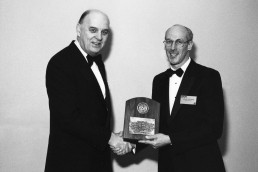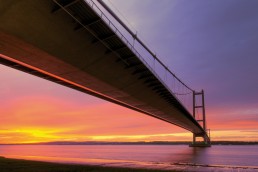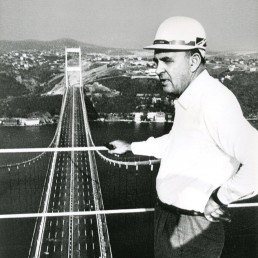

The Times
May 2005
WILLIAM BROWN
Engineer in the heroic mould who designed many of the world’s most elegantly adventurous suspension bridges
Large suspension bridges rank among the world’s most sublime and heroic structures, and Bill Brown played a vital role in the design of the great series of suspension bridges over the Forth, the Severn, the Humber and the Bosphorus which were longer and more elegant than anything built before.
In an era when it has become possible to build cheaper cable-stayed bridges of increasing length, Brown remained the world’s foremost and ablest advocate of the long-span suspension bridge, and for more than 30 years he was engrossed with the design of by far the longest suspension bridge yet conceived — the awesome Strait of Messina crossing, with a central span of 3,300 metres.
Born in South Wales in 1928, Brown studied engineering at University College, Southampton, and Imperial College, London. He joined the famous engineering firm of Freeman Fox in 1956, serving as partner from 1970 to 1985.
At Freeman Fox he was working as No 2 to Gilbert Roberts on the Severn and Forth bridges, both adventurously long spans. When the Forth bridge was given prior approval they were able to refine the Severn Bridge design, producing the first of a new generation of aerodynamic bridge decks.
The two went on to design the breathtaking span of the Humber Bridge, then the longest suspension span in the world.
Brown played a leading role in the first Bosphorus bridge linking Europe and Asia. Seen from the water, it is ethereal, almost ribbon-like in its slenderness, effortlessly carrying a nose-to-tail stream of heavy lorries. The opening of the bridge made Brown a national hero in Turkey, not least because it paid for itself within two years when earlier studies had suggested this would take 20. He was both engineer and project director of the equally elegant second Bosphorus bridge.


New Steel Construction
May 2005
William Brown, one of the leading figures in long span bridge design, has died. Mr Brown, 76, was best known for his contribution in the pioneering team at Freeman, Fox & Partners which developed aerodynamically advanced decks for suspension bridges first seen in the first Severn crossing and later on the Humber and Bosphorus bridges.
Mr. Brown played a significant role in many long span bridge designs, including the Forth Road Bridge, the Severn and Wye crossings, Auckland Harbour Bridge, the Erskine Bridge over the Clyde, and the two Bosphorus bridges. For many years had been promoting the concept of bridging Messina Straits and was engaged on design work for it up until his death in London on 16th March.
Mr. Brown graduated in engineering from University College Southampton, and also studied at London Univerity’s Imperial College which made him fellow in 1987. He was a partner at the world famous long bridge design specialists Freeman Fox & Partners for 15 years from 1970.
As an independent consultant – Brown Beech & Associates – he worked for a large number of clients worldwide, including directly for the Turkish client for the second Bosporus bridge whose construction he oversaw. This role brought him to the attention of the world press in a way few bridge designers ever achieve.
His early career was marred by the collapse of the Milford Haven box girder bridge during construction, which killed several workers. This was followed by another Freeman Fox box girder collapse at the River Yarra in Australia. Brown overcame these setbacks and became one of the world’s leading designers of bridges in steel.
He also developed the system for spinning cables used on the Storebælt crossing in Denmark. His controlled tension spinning method was used to spin 20,000 tonnes of steel wire in only three months. Brown’s awards included an OBE, and the first McRobert Award. He was Master of the Royal Society of Arts’ Royal Designers for the Industry between 1983 and 1985, and was awarded the John A Roebling Medal for lifetime achievement in bridge engineering in 2004.


Bridge Design & Engineering
May 2005
UK long span bridge expert and pioneer of aerial cable spinning and the aerodynamic box girder deck, Bill Brown, has died. He passed away on 16 March after an illness.
Brown’s distinguished career including working as an advisor to engineering companies and consultants all around the world, and his 40 years experience in the design and construction of very long span bridges culminated in his work as lead designer for the Messina Bridge.
Brown was born in South Wales and was extremely proud of his Welsh roots. His father, who was a local politician, had campaigned long and hard for a bridge over the Severn Estuary. According to Brown’s brother Jehoiada, their father would have been delighted to see if being built, and would also have been slightly surprised that Bill was involved with it. After graduating from Imperial College in London, he joined consultant Freeman Fox and Partners, where he initiated new concepts in the design, fabrication and construction of many long span bridges and special structures, such as the Forth Road Bridge, Severn, Humber, Wye, Auckland Harbour Bridge, Erskine, Avonmouth and Bosphorus Bridges.
As well as working on the design of the Bosphorus Bridge, he was resident partner in Istanbul during his construction on 1972-3. When the Turkish government decided to build the Second Bosporus Bridge in 1985, they again called on Brown to act as engineer an project director for construction. In 1987, Brown established his consulting engineering practice Brown Beech & Associates, and started this mammoth task as lead designer for the 3300m long main span and Messina Crossing.
He also worked as technical director for construction and erection equipment for the contractor on Denmark’s Storebaelt East Bridge, at the time a record breaking suspension bridge span.
At a memorial service held in London last month (April), Brown’s brother recalled how when he had set up his own consultancy, many people had wondered who this Mr Beech was, with whom Bill had decided to establish the firm. In fact, revealed his brother, there never was a Mr Beech. Bill had simply thought the name sounded grander, and the choice of name related back to their family home, which had beech tree in the garden.
Brown was also remembered by his brother as a ‘stickler for perfection’ “There was no room in his life for mediocrity ,” he said. He was also extremely loyal, once he had set his mind on supporting a particular point of view or cause, but demanded that loyalty be returned when required.
His list of qualifications and awards was extensive – including the Order of the British Empire, in recognition of his services to the country. He was author of many patents for innovations in long span bridges. These patents included methods of aerial spinning of cable wires and the design of suspended decks to overcome problems of instability under wind loading. He also developed a new cable configuration for suspension bridges to increase stiffness.
His expertise extended to cranes, radio telescopes and other special structures as well as bridges. He devised the concept of single box section jibs and crane girders, which was subsequently adopted universally.
Brown was a strong advocate of the need to base new national standards and codes of practice on properly conducted research. He was openly critical of codes developed from academic hypotheses unsupported by experience.
One of his most unusual professional memberships was the Faculty of Royal Designers for Industry – an elite group of up to 200 members from varied design backgrounds, such as furniture makers, fabric designers, potters, engineers, and part of the UK’s Royal Society of Arts.
The distinction ‘Royal Designer or Industry’ was established by the RSA in 1936 with the aim of encouraging a high standard of industrial design and enhancing the status of designers. It is awarded to people who have achieved ‘sustained excellence in aesthetic and efficient design for industry’.
Brown appreciated the fact that the faculty allowed him to mix with such a diverse range of designers, and when he started his own company furniture, fabrics and so on from his fellow members.

The Daily Telegraph
May 2005
DR WILLIAM BROWN
The Duke of Gloucester, President, the Britain Nepal Society, was represented by Sir Neil Thorne at a service of thanksgiving for the life of Dr William Brown held yesterday at St. James’s Church, Piccadilly, W1.
The Rev Dr Charles Hedley officiated, assisted by the Rev Walter Barbour who read the lesson. Dr Andrew Brown (nephew) read “He is gone…” Dr J.J. Brown (brother) paid tribute to Dr Brown and Mr Geoffrey Hartcourt, Master, Faculty of Royal Designers for Industry, and Mr James Emmett (nephew) gave addresses.
The Ambassador of Nepal also attended and the ambassador of Turkey was represented by Mr Ferhan Erkmenoglu, Deputy Head of Mission. Among other presents were:
Mrs Brown (widow), Mr Douglas Emmett (brother-in-law), Mrs J.J. Brown (sister-in-law), Mrs Andrew Brown, Mr and Mrs Christopher Brown, Mr and Mrs Benjamin Hepden.
Sir Timothy Daunt, Chairman, Anglo-Turkish Society, and other members of the Society; Col G. Birch, Chairman, British-Nepal Society, and other members of the Society; representatives of the Royal Society of Arts, the Institution of Civil Engineers, the Women’s Council, Freeman Fox and Partners and Brown Beech and Associates, together with other colleagues and many other friends.
Dr William Brown was principal designer for many of the world's greatest long-span bridges and he significantly advanced solutions to aerodynamic torsion in bridge decks.
New Civil Engineer
New Civil Engineer
24 May 2005
Bill Brown, perhaps the most inspirational bridge engineer of the last half century, died last week at the Chelsea and Westminster Hospital aged 76.
His last regret was that he did not see the Messina Straits Bridge built, according to his wife Celia. Known on this project as the “father of the bridge”, he was thinking and sketching ideas right up to the end.
Dr William Christopher Brown was principal designer for many of the world’s greatest long-span bridges and he significantly advanced solutions to aerodynamic torsion in bridge decks.
His achievements included the Forth Road Bridge in 1964, the Severn and Wye crossings in 1966, Auckland Harbour Bridge in 1969, Erskine in 1971, Bosphorus One in 1973, the Humber in 1981 and Bosphorus Two in 1988.
His latest success was cable spinning for the Storebaelt crossing in Denmark, the world’s second longest suspension bridge. Using his new “controlled tension” method, 20,000 tonnes of steel wire were spun in three months.
Born in South Wales in 1928, Brown studied engineering at University College, Southampton, and Imperial College, where he was made a fellow in 1987. His busiest years in practice were with Freeman Fox & Partners where he was a partner from 1970 to 1985.
Then came Brown, Beech & Associates, with an office off Kensington High Street and his pet wind tunnel, an arrangement that straddled two rooms and gave accurate results more cheaply and quickly than established research tunnels.
For many years he crisscrossed the globe, in demand wherever clients wanted long bridges. He wrote many papers and gained numerous awards including an OBE in 1966 and the first McRobert Award presented by the Duke of Edinburgh in 1970. He was master of the RSA’s Royal Designers for Industry from 1983 to 1985 and only last year he was awarded the John A Roebling Medal for lifetime achievement in bridge engineering.
Sydney Lenssen
Infoplus